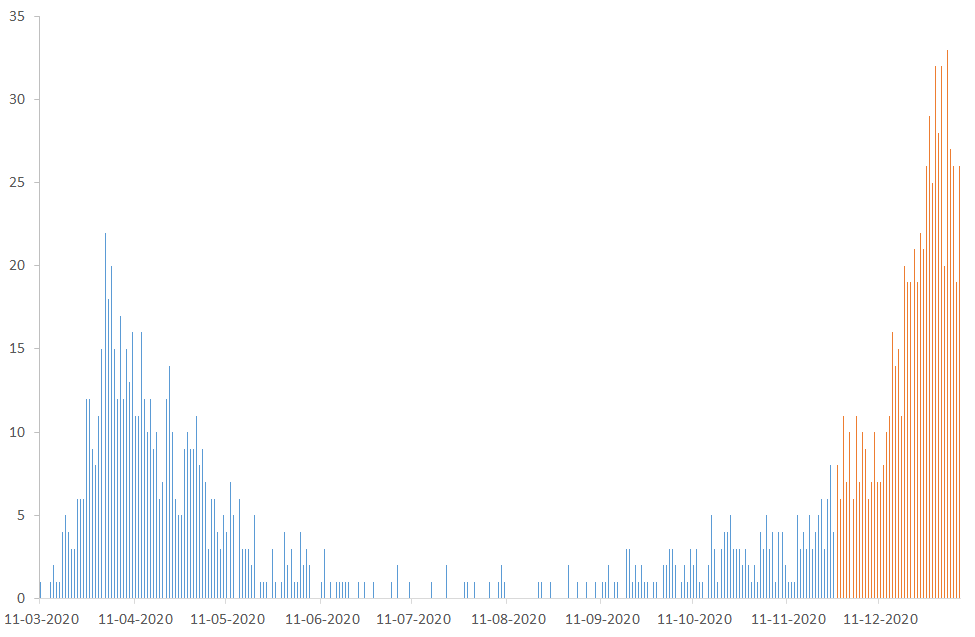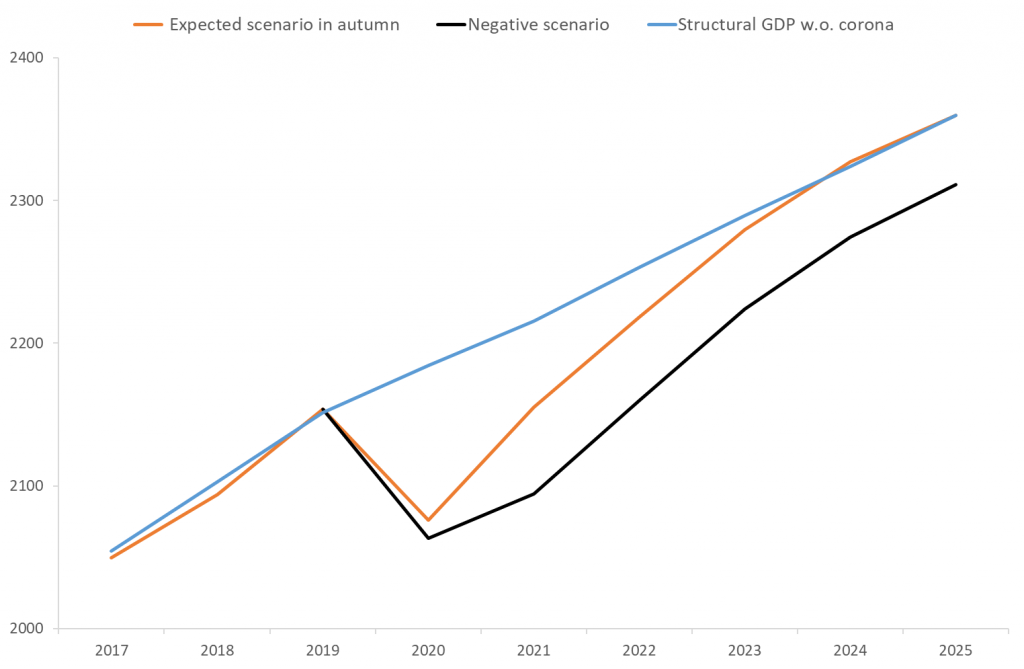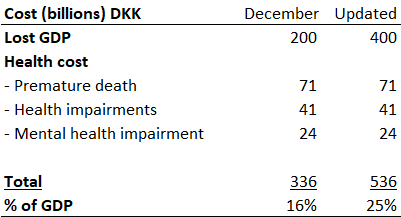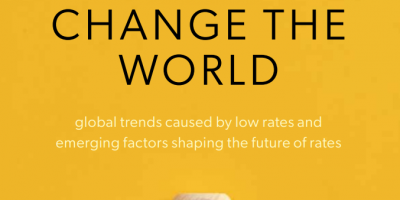Early December 2020, I presented my calculation of the expected cost of the corona crisis in Denmark, taking into account both economic and health-related costs (link). Since then, the situation has turned to the worse, and the expected cost of the crisis has increased by something like 50%. The calculation here is done for Denmark, but given similar types of waves in the US, the UK, and many other countries in Europa, I would expect similar types of consequences.
This graph shows the sad development in the number of people dying with corona in Denmark since March 11, 2020, on a daily basis.

Source: https://en.ssi.dk/.
The blue columns show the daily number of deaths up until November 26, 2020, when I did my initial calculation. The red columns show the numbers since then. From March through November, i.e. including the summer months when few people got infected, approximately 100 people died with corona per month. During the past six weeks, approximately 100 people died per week. During December, more people died with corona than during April.
Economic activity suffers
As a consequence of the dire situation, tough restrictions have been introduced: Max. five people are allowed to meet, people are working from home, “everything” (bars, restaurants, schools, universities, most retail shops, etc.) is closed, etc. Similar restrictions have been imtroduced in many other countries.
Because of the restrictions, economic activity suffers. Forecasts for economic activity have been revised.
In my calculation from early December, I used forecasts from the independent Danish Economic Councils (link). I used their “main scenario” from their autumn 2020 report. The Councils also published a negative scenario. Many economists, including the Council itself, and including myself by the way, now expect that this is a much more likely path for economic activity going forward.

Source: Danish Economic Councils
In their “main scenario”, the Councils expected GDP to fall by 3.6% in 2020, strongly rebound by 3.8% in 2021, and grow by 2.3% per year on average during 2021-2025. Now, a more likely path for Danish GDP is that it falls by 4.2% in 2020, grows by 1.5% in 2021 and by 2.5% per year on average during 2021-2025. In other words, due to the worsening of the situation since late November, the fall in economic activity during 2020 will probably be larger and, in particular, the rebound during 2021 will be smaller and delayed. Given that we start out 2021 in lockdowns, it is more reasonable to expect something like 1.5% growth in 2021, instead of 3.8%.
This figure collects the expected path of GDP without the coronacrisis (“Structural GDP w.o. corona”), the path expected in autumn, and the path that I and many other economists expect now (“Negative scenario”)

Source: Danish Economic Councils
As is obvious from the graph, the expected reduction in GDP is just so much bigger now. More precisely, the expected loss in GDP due to corona (the reduction in GDP due to corona) is now app. DKK 400bn. This is basically two times the loss of economic activity expected just one month ago. This illustrates the costs of an additional wave of the coronacrisis.
Health-induced costs
Health-induced costs depend on the number of deaths, as described in my December blog post (link). In my December post, I assumed that the rate of deaths prevailing at the time of writing would continue for one more year. This was an assumption similar to the one used by Cutler & Summers for the US. This accumulated to 2100 expected deaths in total in Denmark. I argued that this was an aggressive assumption, given that I hoped vaccines were about to be rolled out, but it was the one used by Cutler & Summers, so I used that, too, such that I could compare costs for the US and Denmark.
Now, unfortunately, the assumption does not look that far off. During the past six weeks only, the number of deaths has increased by 75% in Denmark, from 800 to 1400. Given the severity of the current wave, and the slow roll-out of the vaccines, I do not feel comfortable changing my assumption with respect to the health-induced costs.
Updated expected cost of the crisis
This table collects my updated expected economic costs of the corona crisis in Denmark, together with my December expectation:

My estimate of the expected total cost of the crisis has increased from DKK 336bn to 536bn. This corresponds to 25% of pre-crisis Danish GDP, up from 16%. It also corresponds to app. DKK 90,000 per Dane (app. USD 15,000), compared with my best guess of DKK 60,000 per Dane in late November/early December (app. USD 10,000). In just six weeks, due to a terrible second wave of the corona crisis, the cost of the crisis has increased by something like 50% on a per-capita basis.
Conclusion
Obviously, there is a lot of uncertainty surrounding calculations such as these. The mere fact that six weeks of new data can change the economic outlook so much bear this out. Also, I use forecasts from the independent Danish Economic Councils. I expect all forecasters to agree that the economic outlook has turned to the worse, but exactly how much probably differs from forecaster to forecaster.
It is good with one number, DKK 536bn, as we then have something to remember and compare with. With so much uncertainty, on the other hand, we should not be surprised if the final cost will differ from this forecast. In general, whether we talk about forecasts of costs of crises, general economic forecasts of GDP, interest rates, exchange rates, or whatever, it is seldom that forecasts are spot on.
Forecasts such as these help us, though, to understand the magnitude of the crisis. The cost of the crisis (in Denmark) will be in the hundreds of billion Danish kroner. Of this, I am confident. Right now, I believe that something like DKK 500bn, or 25% of GDP, is a good estimate. This estimate might change, but I am reasonably confident that the cost of the crisis will end up being measured in double-digit percentages of GDP. This is the important take-away, not the exact number.
Given these high costs, we should do everything possible to try to reduce them. In particular, the faster vaccines are rolled out, the better. What is difficult to comprehend, I think, is that measures to expand vaccine production capacities were not taken in autumn, when everybody could see that the vaccines were on their way (e.g., by licensing production of vaccines to factories with spare production capacity, etc.). I thus cross my fingers that the rate of vaccination will increase significantly within a not too distant future, thereby helping to contain the otherwise very high cost of this crisis. A Danish newspaper had this cartoon yesterday, link, showing me arguing for the importance of a fast rollout of the vaccines.


